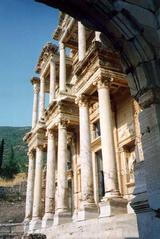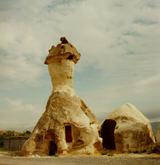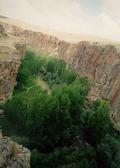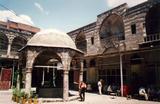
| We arrived in Turkey from Rhodes, Greece. The largest and best-restored "Greek-style" ruins in Turkey are at Ephesus. This is the Library of Celsus (Caesar). | 
|
The landscape of Cappadochia is truly fantastic. The prime feature is the soft, crumbly rock they call "tufa". It erodes into ridges, then upright cones or even more bizarre shapes. The material is pretty crumbly, but when exposed to air, it hardens. This makes it the perfect material for digging caves, or chapels. Most of the larger cones and hillsides have niches, homes, or chapels carved into them. The soil is very rich, making Cappadochia the breadbasket of Turkey. They also make lots of awful wine.

| The nearby area of Zelve features "fairy chimneys". This one apparently has an inhabitant. |

| A little river has cut a lush, green gash in the landscape of Cappadochia. You can descend into the valley and hike through it. |
And don't even get me started on the pistachio-based desserts.
I went with a tiny tour group to see Nemrut Dagi at sunrise. We left around 3 in the morning for the long drive up the mountain. Normally, I would not bother going anywhere this early, but I didn't think I had a choice. With the Oçalan trial going on, there were so few tourists that I had to take what I could get in the way of transport to tourist sites. Almost all of the people there at sunrise were Turkish university students. Some had guitars, and there were huge outbursts of Kurdish song. I checked my Turkish guide for his reaction, but he seemed nonplussed. The crowds left right after the sun had risen, and we had the mountaintop nearly to ourselves.
Southeastern Turkey is predominantly Kurdish. Many identify more closely with the Kurds in the neighboring countries of Iran, Iraq, and Syria than with Turks. Until recently, Turkey had tried to assimilate the Kurds by banning the use of the Kurdish language and other cultural displays. Nowadays you will hear Kurdish pop in the east. However, some of the old fears of persecution remain. I learned how to greet people in Kurdish, which is usually warmly received, but some people nervously looked over their shoulders before smiling and answering back in Kurdish. I certainly wouldn't use Kurdish in front of the police.
There is certainly less tourism in the Kurdish east than in the Turkish west and south. Many people go to Turkey for the beach, but the east has so much history. The other thing that deters tourists is the PKK. The threat of the PKK to tourists might be overestimated, and I asked around to find out where the dangerous spots were. The only two were in Tunceli and Hakkari. Too bad, as many of the best traditional Kurdish textiles come from Hakkari, where violence broke out when Oçalan was sentenced.
I was traveling in a small tour van with a blonde woman and her parents. At the Ataturk Dam, a bunch of young Turks wanted to get this woman into their photographs. I figured that blondes were novel enough around here that she'd get bugged a lot. I offered to take their picture with her, then they waved me into the photo, then her parents. One of the young Turks finally took it.

The city of Diyarbakir was mentioned in the World's Most Dangerous Places travel guide, so I stopped by. It is an old city on the banks of the Tigris. The architecture is distinct, featuring alternating bands of black basalt and white stone. The city was once very heavily fortified, surrounded by concentric massive walls. The outermost one is pretty much intact.
The city receives few foreign visitors. When I arrived, I took a local bus and asked (in bad Turkish) to be dropped off at a particular intersection in the town center. Instead, I was dropped off somewhere nearby, and a small boy led me to a bank. Puzzled, I asked the person at the front desk if anyone spoke English. A suprised-looking man stood up behind him and told me that he did. He recently arrived from Western Turkey, having just started his job at this bank a month or so ago. He was startled to see a tourist in Diyarbakir, and told me that tourists come to Turkey for "sun and sex". He said that you go south and west for the beaches, and the center and east for history. Perhaps this is all the tourist information one can get in English in this town. He then gave me his phone number in case I needed help and directions to a nearby hotel.
There were many students in town. I was talking to a couple of med students on the top of the outermost city wall, when they abruptly said, "if he asks, tell him you don't know us," and wandered off a couple of paces looking nonchalant. A policeman walked by, and the med students returned and we continued talking.
I don't have photos of any tourist sites in Van. It is only a few kilometers from Iran, and I bumped into a couple of Iranian refugees there. I was actually kind of disappointed. I was hoping that by travelling as far east as I could, I'd see a totally different place. But Van is just a quiet college town with lots of patroling soldiers. I intended to visit the nearby Akdamar Kilisesi (castle), which is on an island in a lake, but it would have been prohibitively expensive. If there were more tourists, there would have been a regular minibus service to Akdamar, but threats of PKK violence kept visitors away, and the only way to get there is to hire a car (approximately $100). And there's the matter of figuring out how to get from the lakeshore to the island. The other postcard-worthy target is the Van cat, which is a fluffy white cat with one green eye and one blue. Didn't see a single one. Someone explained to me that people often keep them indoors so they don't get stolen.
I may have been the only tourist in Van. When I went to dinner, lots of servers would stop by to say hi, and at one point, the cook stepped out to give me extra sauce. Lots of young kids wanted to practice their English on me. A few showed me a around town a bit, stopping by the stores of their relatives for a cup of tea (and happily not to buy things).
I visited Van Kalesi, just on the edge of town. It is a large structure on a hill, largely in ruins. The side of a sheer cliff under the castle was full of little burial caves surrounded by interesting cuneiform writing. These areas were completely enclosed in cyclone fencing with a catwalk underneath. I assume that these were open when there were tourists. I was the only one there, so I had to cling to these fences in order to see anything.

I took a minibus ride to the town of Dogubeyazit, which is a little north and east of Van. I was told that you can get consumer goods cheap, as it is on a popular trading and smuggling route with Iran. I came to see Ishak Pasa, an 18th- century castle on a hill. I stopped by the tourist office, where the guy wanted to sell me a tour of the Ishak Pasa, the Iranian border, and a few other sites. Unfortunately there were no other tourists around, making the tour prohibitively expensive. I told him that I'd just get a cab to the Ishak Pasa, and he plaintively asked if he could come along because he was so bored. We went together, and the castle was beautiful.
I was stuck in the remote town of Igdir for a few hours. It was the only town I could get to from Dogubeyazit. At the bus station, I talked to a couple of Turkish students waiting to catch the $25, 30+ hour bus back to Istanbul. They were reading a newspaper, and on the front page I recognized a scene from "Midnight Express", which is still much-hated in Turkey. A couple of days later, I saw that the TV news was running stories about how a Turkish police officer was offering evidence that the events of "Midnight Express" were lies. I stopped by the little food mart at the station, which was run by a curly-haired young boy. When he saw me, he asked (in Turkish) if I was Chinese. When I gold him that I was, his eyes lit up and he removed my glasses so he could stare at my face. I then noticed that his features were vaguely Asian. He put my glasses back on, then started ripping open little packs of chips and sodas and handing them to me. I could not understand him, but his pleasure was obvious. I have no idea why he was so excited to meet an Asian.
I ran into a couple of British tourists who claimed that the Turks along the Black Sea are the friendliest in Turkey. In small towns, they never had to pay for a hotel room. It was an honor to show hospitality to foreigners.